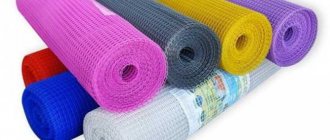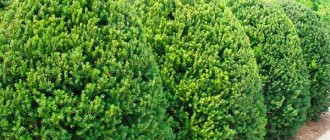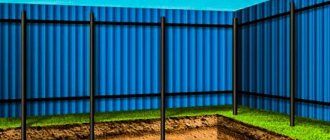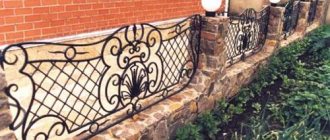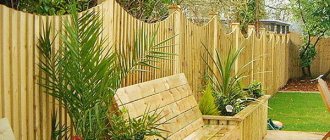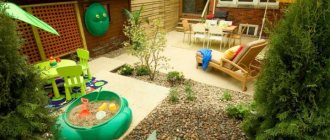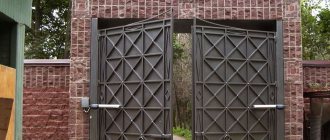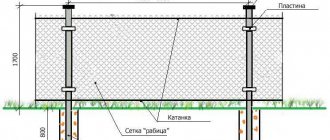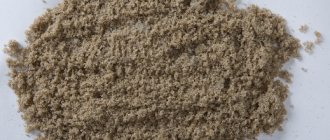Many summer residents often think about what kind of fencing to frame their plot in order to make maximum use of the area along it. After all, some models of blind-type fences do not allow light to pass through and provide a persistent shadow. The cost of enclosing structures also plays an important role. Optimal solutions may be fences made of gitter mesh, fences made of chain-link mesh. Photos of inexpensive fences clearly demonstrate lightweight structures and ways to decorate them.
Gitter welded mesh is weather resistant and does not block the penetration of sunlight
Gitter mesh fences, chain-link fences. Photos of structures, their advantages
Having looked at the photos of garden fences made of mesh (chain-link, gitter), you can be convinced that high-quality and neatly installed fences have a quite decent appearance. They share the following advantages:
- fences fully cope with fencing functions, preventing unwanted entry into your territory;
Chain-link fence decorated with weaving
- fences made of mesh are light- and breathable, which allows you to use the area along them for growing various crops, as well as avoid conflicts with neighbors regarding shading of one or another place on someone else’s territory;
- structures can be used as a basis for climbing plants;
- mesh fences are easy and quick to install; anyone can install a fence, even without experience in construction;
- the cost of such fences is quite affordable and affordable to almost any summer resident;
- Modern polymer coatings provide mesh fences with corrosion protection and a fairly impressive service life.
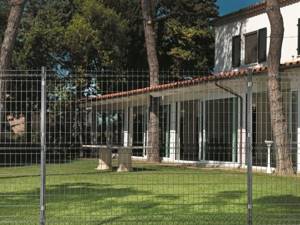
The rigidity of the structure guarantees no sagging of the fence made from the gitter mesh
Lightweight fences made of mesh do not require a foundation - for their supports, it is enough to securely install pillars by driving them into the ground or concreted. Traditionally, a fence made of mesh is installed to mark the perimeter and fencing the entire household territory or to divide the area between neighboring dachas. The latter option allows you to install the front part of the fence from more expensive materials, and decorate the border with mesh, which will significantly reduce the cost of constructing the fence.
If the owners wish to make their site inaccessible to view, they can decorate fences made of nets with various types of climbing plants (climbing roses, clematis, ivy), shrubs, or decorate them with a camouflage mesh for the fence. It is worth noting that good quality camouflage nets can last for several seasons, they are invulnerable to negative atmospheric influences and do not lose their appearance after being treated with detergents.
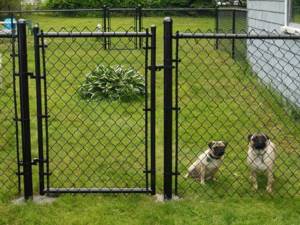
Chain-link mesh is considered a reliable and inexpensive material for fencing
Gitter mesh properties
With the advent of the gitter mesh, the appearance of mesh fences has become more improved and noble. Gitter mesh consists of separate sections of rods welded together, which are attached to the posts with special clamps. The strength of such structures depends on the convexity of the mesh surface, due to the presence of anti-deformation stiffeners.
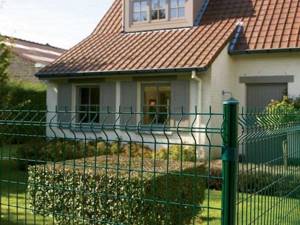
Thanks to the polymer paint coating, the gitter mesh is not susceptible to corrosion
The mesh rods are made of steel wire Ø 3.5-5 mm. For anti-corrosion protection, the wire is coated with a polymer or galvanic coating. The panel size is traditionally 2×2.5 m, the cell size is 50×100 mm. Anti-deformation ribs help maintain the shape of the mesh for a long time and increase its performance properties. The strength level of panels made from gitter mesh is comparable to the strength of fences made from corrugated sheets.
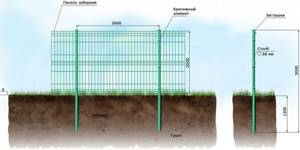
Scheme for installing poles for a fence made of Euro mesh
The main properties of the gitter mesh include sufficient resistance to external factors, simple and quick installation, the ability to replace failed elements without compromising the integrity of the entire fence, durability and versatility of use. It is successfully used for fencing private areas, playgrounds, parking lots, office and industrial areas.
In the industrial sector, fences made of gitter mesh are used if it is necessary to ensure good visibility of the site. To enhance the protective functions, the fence made of mesh is supplemented with L-shaped holders. Subsequently, barbed wire, network video equipment or motion sensors can be fixed on them. If necessary, such device systems can also be used for private areas.
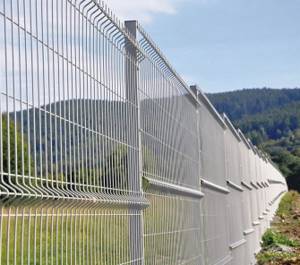
Fence installation technology allows you to take into account all surface irregularities
Another advantage of the gitter mesh is the ability to choose the material in different colors. The most popular are meshes with green polymer coating. A fence of a color close to natural greenery goes well with the landscape and complements the landscape. However, it is possible to choose a different shade based on your personal preferences.
What types of mesh are suitable for fencing?
The main difference criterion is the material from which the mesh is made. Let's take a closer look at the popular types, their operating properties and application features.
Made of metal
Used for separation:
- two different land plots;
- vegetable gardens;
- industrial buildings;
- areas for walking livestock.

The raw material is steel, which is coated with brass, a layer of zinc, plastic, or remains in its original form.
Galvanized metal fence mesh is not afraid of constant exposure to precipitation and moisture. They are easy to repair and easy to install.
Chainlink
Quite popular among summer residents. Made from braided round steel wire. Service life - up to 50 years. Supplied in rolls. The cell sizes are different - from 0.25 to 0.7 cm and are selected individually. When choosing, it is worth considering that:
- The fence will be stronger if you take a chain-link with small cells, but this will reduce the passage of light into the area.
- The best option for a summer house with a vegetable garden would be material with a cell size of 0.4 to 0.6 cm.
- To fence children's play areas and sports grounds, you should use mesh rolls with cells up to 0.4 cm so that the material is strong enough to withstand impacts from balls and toys.
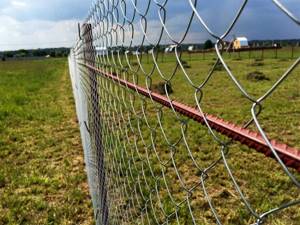
Photo: the territory of the agricultural plot is fenced with a chain-link mesh
A good decorative option is to plant climbing roses and grapevines around the perimeter of the fence. In summer, such a green wall will close the estate from prying eyes.
The chain-link is produced in several types:
- Non-galvanized. Made from black steel. The material is not protected from corrosion, so it requires painting to extend its service life. We recommend reading: “How to paint a metal fence.”
- Galvanized. The mesh has a more reliable coating, but is also more expensive. Color - gray.
- Plasticized. A layer of plastic is applied to the metal. Due to this, the material lasts longer, does not corrode, and is resistant to environmental influences.
Dyed chain-link is available for sale:
- green;
- brown;
- red;
- yellow;
- black.

Important advantages of chain link:
- low price;
- ease of installation;
- suitable for fences with different purposes;
- the mesh can be used repeatedly;
- repairable;
- Convenient to transport.
Separately, it is worth highlighting the resistance of this mesh to high temperatures, without loss of working properties.
Thematic material: “How to make a chain-link fence.”
Welded
The base is steel wire with a diameter of 3–5 mm. The average cell size is 100*150 mm, popular shapes are square, rectangle. Available in cards (sections in the shape of a square) measuring 2*2.5 m.
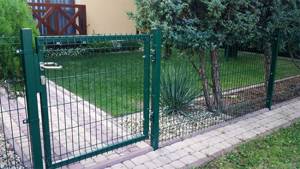
All welded mesh rods are fastened together at the intersection points by spot welding, hence the name.
It is considered the most durable and reliable type for fencing.
Each sectional element of wire is supplemented with stiffening ribs, which significantly increases the stability of the finished structure.
Available in the following colors:
- blue;
- red;
- white;
- green.
Welding technology is performed in two ways:
- Pre-galvanized. A significant drawback is that when connecting rods by welding, part of the galvanizing peels off, which causes corrosion on the metal surface.
- Galvanizing after welding. Much more effective than the first method. The fence will be more durable and more resistant to the external environment. It is possible to apply an additional polymer layer.
Most welded fences are made with protrusions that prevent intruders from entering the territory.
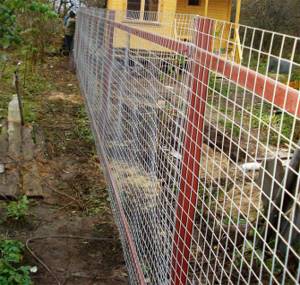
Sectional mesh is used for modular fencing around country cottages, private sports grounds, and industrial buildings.
When creating a decorative fence, corrugated rods can be used, which visually make the patterns three-dimensional. Welded mesh with a 3D effect will look beautiful and will last at least 20 years.
Among the main advantages of this material are:
- choice of any fence height;
- quick assembly of sections due to the complete set of fasteners;
- the ability to replace the old card with a new one;
- strength, resistance to mechanical damage;
- aesthetics.
Flaws:
- high price;
- heavy weight, which requires the involvement of assistants during the installation of sections;
- If the mesh is not galvanized and there is no polymer layer on it, the fence will have to be painted periodically.
To install the spans, you will additionally need metal corners and profile pipes.
Grooved

Another name is canned. Made from black carbon steel. The wire profile is bent, giving it a wave-like shape. The rods are then woven together like thread to produce fabric. It has high strength and rigidity, due to which it is produced not in rolls, but in cards.
The diameter of the rods ranges from 2 to 7 mm.
For country and sports fencing, corrugated mesh up to 3 mm thick is sufficient.
The cell sizes are different: from 1*1 to 10*10 cm. For fences, it is better to take material with the largest cell size.
Such raw materials will become the basis of a strong and reliable fence, but its only drawback will be its high cost.
With polymer coating (Euro mesh)
If you choose a durable and at the same time beautiful material for a fence at an affordable price, then Euro mesh, one of the welded types, is perfect. It is made of interlaced steel wire, covered with a layer of PVC on top. The polymer is applied by baking.
Diameter - 2.5 mm. The size of the cells is 50*50, 100*50 mm. It goes on sale in rolls. Each height is 2 or 1.5 m, length is 25 m.
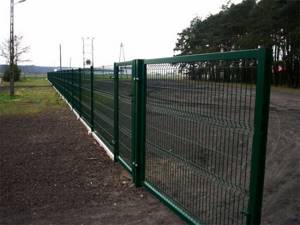
Photo: using Euro mesh as a fence for private territory
The advantages of polymer-coated mesh are as follows:
- provides high structural rigidity;
- durable and reliable;
- is inexpensive;
- does not fade, does not crack;
- resistant to moisture and temperature changes.
- presented in different colors;
- looks beautiful.
One square meter of such a fence will be several times cheaper than a fence made of chain-link, wood, siding or corrugated sheets, and the service life of the Euro mesh is not inferior to any of the other types.
If the surface of the mesh is damaged, the unprotected steel begins to rust, so you need to select the mesh carefully, inspecting the surface for cracks and defects.
Lightweight
Made from thin wire resembling thread. The transverse and longitudinal rods are attached to each other by a hinge unit. The size of the cells within one roll varies. First there are cells with a height of 15 cm and decrease with each row to 5 cm, then increase again. This type of weaving provides the mesh with sufficient strength, despite the fact that the wire is thin.
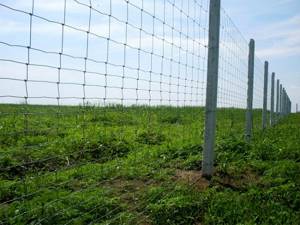
Photo: using lightweight mesh as a temporary fence
This is the cheapest type of metal mesh, but it is recommended to use it only when installing temporary fencing, since its service life does not exceed 5 years.
Gabion
This original fence is made from rectangular, square, cylindrical welded or twisted wire boxes, the cells of which can have different shapes and sizes. Moreover, the boxes are not left empty, but filled with natural materials (tree cuttings, stones, crushed stone). This innovation in landscape design will turn a fence into a decoration for your estate.
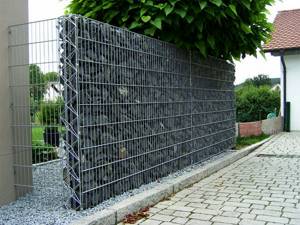
Photo: gabions in landscape design
Made of polymers, PVC
It is created from extruded polymer fibers that are intertwined to form a mesh. Often used:
- as a garden lattice to separate areas of flower beds and front gardens;
- as the main fence for a summer cottage;
- for emergency construction (in rare cases).
Sold in rolls, weighs little.
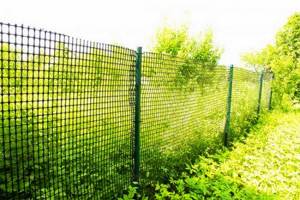
Photo: plastic garden net
At the same time, it is an excellent support for climbing plants.
Other advantages of plastic mesh include:
- Installation speed. Roll material allows you to assemble fences without unnecessary joints and additional fastenings.
- Easy to transport due to light weight.
- Large selection of colors and cell shapes.
- Resistance to any influence of the external environment.
- Design safety. There is no risk of injury, unlike metal mesh.
- Does not require maintenance.
- Service life up to 40 years.
- UV resistance.
- Non-toxic.
A significant disadvantage of PVC mesh is low strength. Such a fence will not protect the estate from intruders, so it is better to use it for zoning the site.
Camouflage
Another name is camouflage. A great addition to the regular grid. Protects the garden area from scorching sun rays and prying eyes. Previously it was used only to camouflage military installations. Now used by private sector owners.
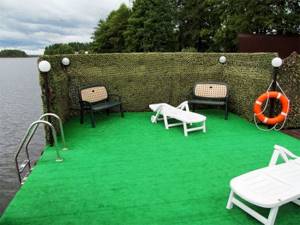
Photo: decorating the pier with camouflage netting
Photo grid
Used to decorate finished fencing. It is made of polymer fabric, on top of which an image is applied.
Happens:
- solid (standard banner fabric);
- mesh.
For fences, the second type of photo mesh is used due to the lack of windage during wind and good air exchange.
This fence is not visible from the street. This spectacular decoration of the estate will not cost much.
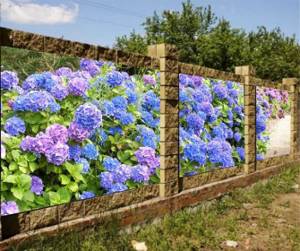
The outer part of an unsightly fence, construction work, and recreation areas are decorated with a photo grid.
From fabric
It is made from thin metal wire with a diameter of no more than 0.03 – 3 mm with the addition of polymers. Perpendicular weaving is performed on automated machines. The cells are very small in size. Woven mesh is sold in rolls. Rarely used for fencing, more suitable for camouflaging construction work.
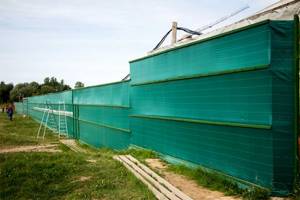
Photo: using fabric mesh as temporary fencing during construction
Installation of a fence made of gitter mesh
Installation of a fence made of gitter mesh is carried out by installing vertical supports around the perimeter and attaching cassettes with mesh to them. The light weight of the material and the ease of attaching the mesh to metal posts allow you to install the fence yourself. The key to the strength of the structure is the reliability and correct installation of the support posts.
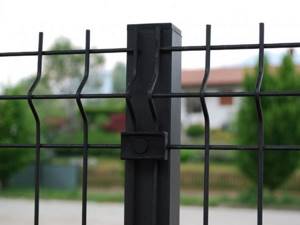
Gitter mesh fencing is quite easy to install and dismantle
For supports, use a profile pipe of square or rectangular cross-section 60×40 mm or 60×60 mm with a wall thickness of 2 mm. Posts can be installed in several ways depending on the type of soil on the site. With the usual method, it is enough to deepen the posts into the ground by 0.9-1 m, and concrete the upper part of the pillar immersed in the ground (about 20 cm from the ground level). The supports are placed at a distance of 2.5 m from each other.
In the case where sandy-clayey soils predominate on the site, they resort to the method of completely concreting the supports. And if the soil is clayey, it is recommended to choose the method of filling the holes around the installed pillars with crushed stone (butting), followed by their compaction and filling with concrete mortar. After the concrete has completely set (about 3 days), you can begin attaching the mesh panels to the supports.
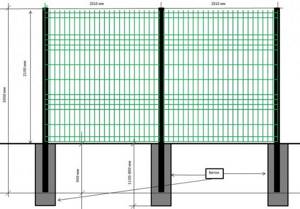
Scheme of installation of posts and steel mesh for a fence
Cassettes with mesh are fixed to the posts with special U-shaped fasteners - clamps, which come complete with the mesh. Using a wrench, tighten the fasteners tightly.
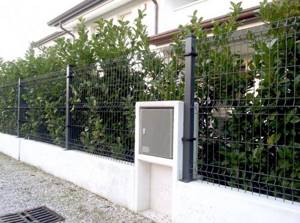
Sections of welded mesh can be easily and quickly secured to special fastenings on poles
Do-it-yourself chain-link fences. Video installation instructions
Chain-link mesh remains the most relevant material for fencing summer cottages and local areas. Photos of chain-link fences demonstrate two methods of constructing such fences. The simplest and most inexpensive option is tension, when the mesh is stretched between support pillars. The second option is sectional, in which the fence is mounted from separate ready-made frames, inside of which a mesh is enclosed.
Installation of support posts and formation of a mesh fence
Metal profile pipes are usually used as support posts for a chain-link fence. Some craftsmen sometimes use wooden beams or logs for racks. A chain-link fence with wooden supports is used if the fence is temporary or if there are excess wooden elements left after the main construction work. But it should be noted that the appearance and durability of such fences will be inferior to their counterparts with metal posts.
Work begins with preparing the area and marking it. In the corners of the perimeter, stakes are driven in and a construction cord is pulled. In order to calculate the required amount of mesh for a fence, it is enough to measure the length of the cord and add 5% of the value to it for the supply of material. After this, you can mark the installation locations of all racks, making the distance between them no more than 2.5 m, otherwise the mesh will sag.
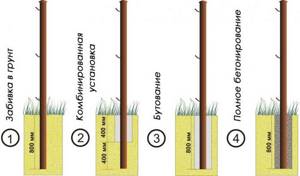
Methods for installing posts for a mesh fence
To install the tables, holes with a depth of at least 1 m are drilled, metal poles are inserted into the holes and concreted. Next, the roll with the mesh is unwound on the ground next to the racks, lifted in one movement and one edge is fixed in several places with the help of wire.
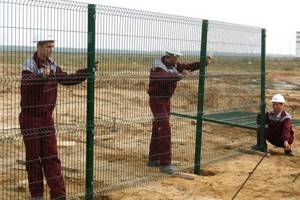
Before installing the fence, it is necessary to calculate and mark the places for placing the posts
Before stretching the chain-link mesh onto the fence, it is necessary to weld hooks to the metal supports. The mesh is fixed to the wooden supports using nails.
Installation of a sectional fence made of chain-link mesh
Installation of supports for a sectional mesh fence is carried out similarly to the tension method. However, racks are used from a metal profile with a larger cross-section due to the fact that the load on them will be greater. The frames for the sections are made from welded corners. Angular steel 30×4, 40×5 mm is used. The frame parameters are determined based on the distance between the supports and the height of the pillars. The frame should be 10-20 cm smaller in width and height than these values.
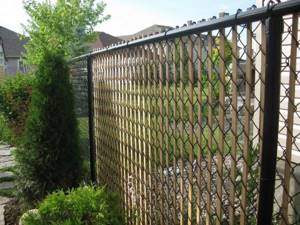
Wooden slats will help add originality to a mesh fence
In order to fill the roll with mesh with mesh material, roll out and cut the canvas with a grinder to the size of the frame. A metal rod is pulled along the outermost row of mesh cells and welded to a vertical support. This is done in turn with each side of the rectangular frame, each time stretching the mesh well.
The finished sections are welded to the support pillars using metal strips. A fragment of a plate with dimensions of 30×5 mm will be sufficient. The strips are welded at a distance of about 30 cm from the top of the rack and from the ground surface. After assembling the entire structure, the welding points are thoroughly cleaned, coated with primer and painted.
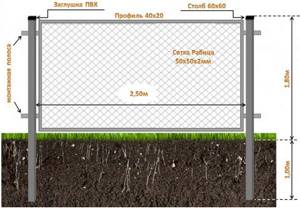
Installation diagram of a chain-link fence in a frame 1.8 meters high
To learn how to make fences from chain-link mesh, just watch the installation videos and take the advice of professionals in this matter. Simplicity and ease of installation allows you to install a chain-link fence with your own hands. Photos of the best solutions can easily be found on the Internet for use as an example.
Photos of chain-link fences
Despite the simple installation algorithm, chain-link fencing can have a different appearance. The most budget-friendly option is a fence, the supports of which are round posts driven into the ground with a sledgehammer. The main thing here is careful tension of the mesh, since the fabric does not have a rigid structure. The more fixation points there are, the more stable the fence will be. Traditionally, such structures are used to mark the boundaries between neighboring territories.
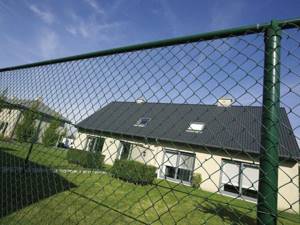
Chain-link fencing is attractive due to its ease of installation and long service life
The fencing is more reliable when the pillars are installed exclusively vertically and concreted. The mesh is tensioned by placing it on hooks that are previously welded to the posts. And drawing a horizontal reinforcing bar strengthens the structure and prevents the mesh cells from deforming.
A fence made from a chain-link mesh stretched over a metal frame made of profile pipes looks more solid. The upper and lower guides are rectangular pipes welded to the racks. This option is quite worthy to frame not only a summer cottage, but also a small country house. The frame can also be assembled from round pipes.
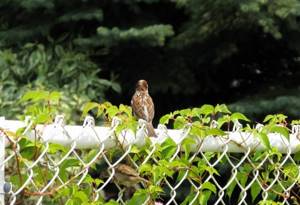
Galvanized mesh has a longer service life compared to regular mesh
To prevent the mesh from growing into the ground, a strip base is installed under the fence. In this case, the lower end of the mesh passes along the concrete parapet, due to which the material is less susceptible to corrosion. The line of such a fence looks smooth and clear, and if you line the parapet with stone, you get a pretty nice design. The cost of such a fence will be higher, but in this way you can protect the area from the penetration of small animals.
An excellent choice is a sectional chain-link fence if the site area has unevenness and differences. Fencing spans installed at different levels completely solve this problem. In addition, the frames of the fence sections can be painted in different colors, which will make it bright and stand out against the backdrop of dull, monochromatic fences.
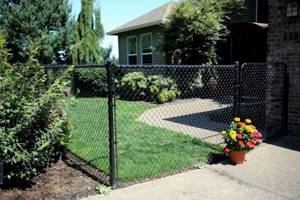
Among the main advantages of chain-link fencing is excellent light transmission
Types of fences
Chain-link is a material prone to sagging. If the fence plays the role of temporary protection of the territory and will be replaced over time, then you can opt for the simplest and cheapest tension fence.
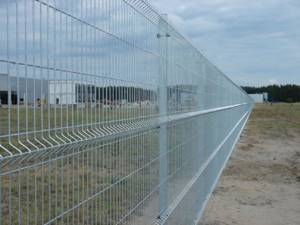
Otherwise, sectional or tension mesh fences with broaches will help increase the service life of the chain-link while maintaining its aesthetic appearance.
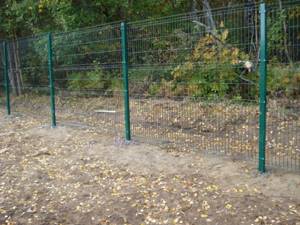
The first option involves using a frame made of a metal corner, the second - drawing strong wire. It is better to make a sectional version of the fence from welded mesh.
Plastic mesh for fences
A relatively new type of material is plastic garden mesh for fences. This mesh fabric is very popular in the construction industry. This universal material is used for concrete screed, masonry, plastering and fencing. With the help of decorative fencing mesh, summer cottages are landscaped, flower beds are formed, recreation areas are fenced, fences are framed, and poultry houses are also erected.

Plastic mesh is a fairly versatile material and is used not only for arranging fences
The main qualitative properties of plastic garden mesh include low weight, resistance to natural phenomena, the ability to withstand temperature changes and not succumb to corrosion. The mesh fabric is convenient to transport and store; packaging it in large rolls allows during installation to significantly reduce material consumption due to the minimum number of connecting lines.
In addition to the high aesthetic and performance characteristics of the material, the price of plastic garden mesh for fences is affordable for any buyer. Estimated cost of plastic mesh with different cell sizes:
| Name of material | Width, roll length, m | Cell size, mm | Grid color | Cost per roll, rub. |
| Plastic fence grate Z-70/1.5/25 | 1.5 x 25 | 70 x 70 | Turquoise | 2310 |
| Plastic fence grate Z-55/1.2/25 | 1.2 x 25 | 55 x 58 | Khaki | 3260 |
| Plastic fence grate Z-55/1.9/25 | 1.5 x 25 | 70 x 58 | Khaki | 3210 |
| Plastic fence mesh Z-55/1.9/25 | 1.9 x 25 | 55 x 58 | Green | 6310 |
| Plastic fence grate Z-10/2/30 | 2 x 30 | 10 x 10 | Khaki | 8310 |
| Plastic fence grate Z-10/20/30 | 2 x 30 | 32 x 32 | Khaki | 9210 |
Fencing made from various types of mesh remains the most popular among summer residents and residents of the private sector. Considering the affordable cost and ease of installation, mesh fences can be successfully erected independently, they have a neat appearance and can last up to 20 years.
Technical characteristics of chain-link mesh
The production of chain-link mesh is carried out in accordance with GOST 5336-80 standards. All types of chain-link mesh can be reduced to several groups:
Material:
- low-carbon steel (the mesh is flexible);
- stainless steel, which imparts rigidity to the mesh.
Outer cover material:
- galvanized chain-link mesh . The thickness of the zinc layer is measured not in microns, but in g/m2. The amount of applied zinc is determined by a laboratory method by weighing a galvanized and cleaned sample. On the market there is galvanized chain-link mesh with an amount of zinc from 10 to 90 g/sq.m. The service life of the mesh depends on the thickness of the zinc coating - from 15 to 40 years. It must be remembered that operating conditions can increase the rate of zinc volatilization from a galvanized surface, which will lead to the early appearance of rust;
- non-galvanized chain-link mesh . It is made of low-carbon wire (popularly called black mesh). It is comparatively cheap, but the absence of any protective coating leads to the development of corrosion. The estimated service life of non-galvanized mesh is up to 10 years. Used in low-aggressive environments, for temporary fencing;
- polymer mesh netting . Designed specifically for conditions with an aggressive environment (by the sea, on livestock farms, in industrial regions with acidic precipitation, etc.). In addition, polymer-coated mesh has several colors (gray, black, green, red, blue), which increases its aesthetic properties. Material prepared for the website www.moydomik.net
Polyvinyl chloride is used as a coating for the mesh, reinforced with various additives, which determine such properties of the chain-link mesh as: resistance to ultraviolet radiation, frost, corrosion, mechanical damage to the coating, and aesthetics. However, it is quite difficult to distinguish visually high-quality coating. You should also know that PVC coating is applied to a galvanized or non-galvanized steel core. The former has a longer service life. The quality of the polymer mesh coating is confirmed by certificates.
3. Cell shape:
- diamond-shaped (diamond-shaped weaving). More common. The acute angle of a rhombus is 60°.
- square (weaving shape).
Cell size
The size of the mesh cells of the chain-link mesh is determined by the distance between the opposite sides of the rhombus, which is called the clearance. You can buy chain-link mesh with mesh sizes from 5 to 100 mm.
It should be noted that GOST regulates the diameter of the wire from which the mesh with a certain mesh size is made. For example, a mesh with a cell size of 10x10 can be made from wire with a diameter of 1.4-1.6 mm. As the cell lumen increases, the diameter of the wire used for its production increases. For example, a mesh with 100x100 cells is made of wire with a diameter of 4-6 mm.
The mesh size of the chain-link mesh and the diameter of the wire determine the strength of the mesh and the entire fence. The smaller the mesh and the thicker the wire, the stronger the fence.
Note. The permissible deviation in cell width is +5 mm, and the deviation in wire thickness is no more than 0.05 mm.
Chain-link mesh dimensions
Standard mesh sizes:
- length 10 or 15 m.p.;
- width 1000 or 1500 mm. Meshes with a width of 500-4000 mm are made to order;
- wire thickness from 1 to 6 mm.
Chainlink mesh weight
The weight of the mesh is directly affected by the mesh size and wire thickness. It is by weighing that it is determined whether the diameter of the wire corresponds to the declared value. The weight of the chain-link mesh 50x50x3 mm is 2.28 kg/sq.m. weight of a roll of mesh netting 1.5x10 m.p. is 34.2 kg.
Lightweight chain-link mesh is also in demand for the installation of temporary fences and barriers. In this case, it is allowed to reduce the wire thickness:
- by 0.5 mm (No. 50);
- by 0.2 mm. (in the manufacture of mesh No. 20, 25, 35);
- by 1 mm (No. 80 and No. 10).
